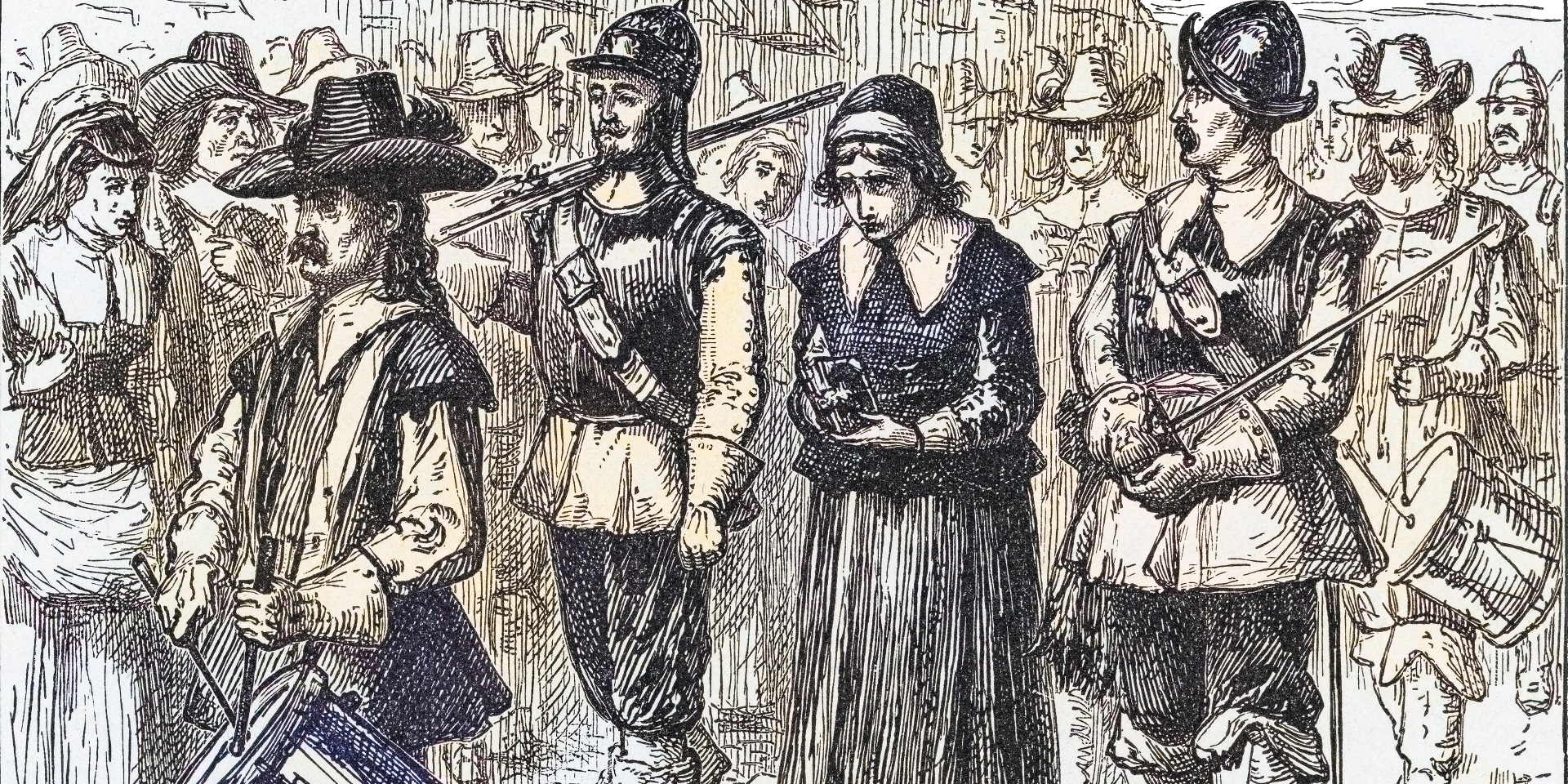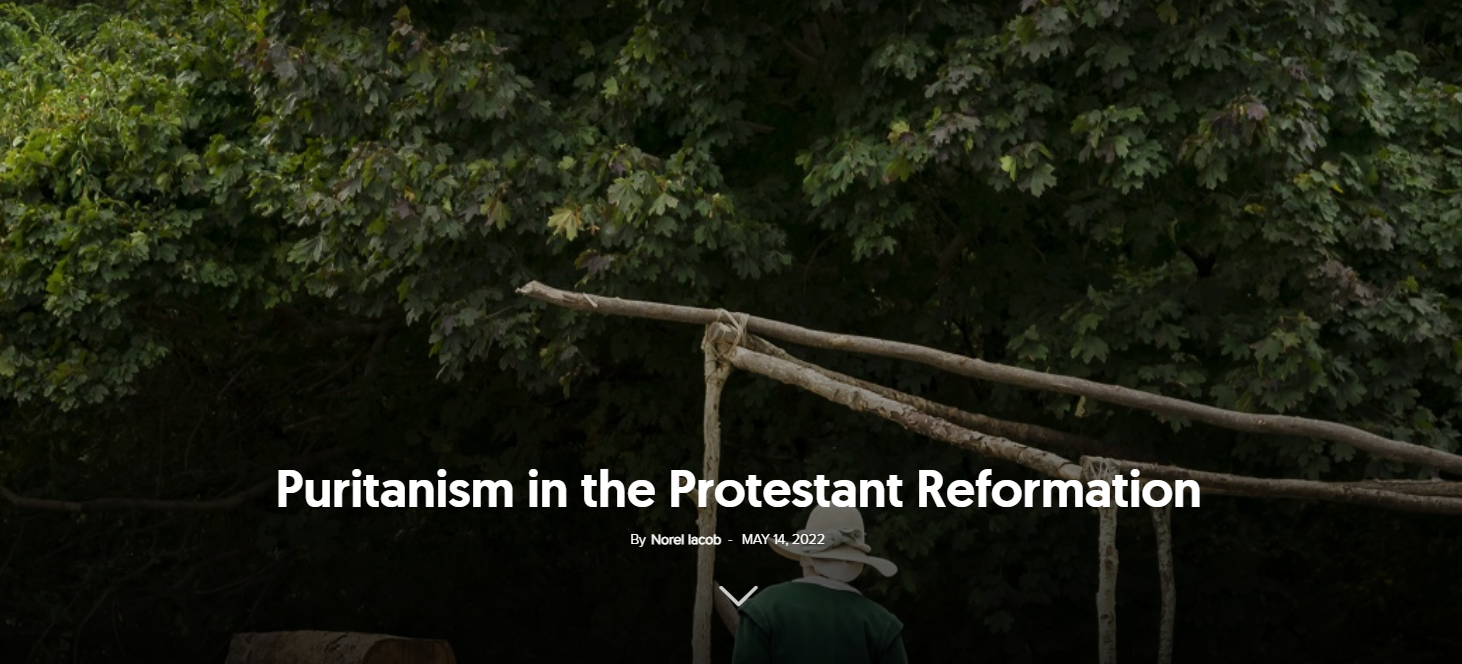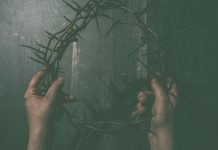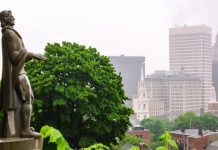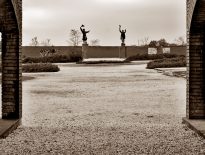That fateful day of June 1st, 1660, was not the first time Mary Dyer wound up at the gallows. The previous time, with her hands tied and her face covered by the handkerchief of her former pastor, Reverend John Wilson, she had escaped death by the skin of her teeth, after a death sentence that had already killed two of her dear friends was revoked.
No one suspected then that her death on the scaffold in Boston would contribute to the end of the Puritan theocracy.
Who was Mary Dyer? Nothing is known about her birthplace. Her biographies begin with the documents that prove she was married in London to a fishmonger turned hatter, William Dyer. Mary and William were Puritans—that is, non-conformist members of the Anglican Church convinced that its practices must be cleansed of Roman Catholic influences.
The Puritans refused to conform to the authorities’ view of worship, at a time when the supreme leader of the church was the monarch of England himself. They wanted to worship as they saw fit: to omit parts of the liturgy in order to save time for the sermon and hymns, not to make the sign of the cross, not to wear wedding rings, not to use the church organ, and for their clergy to dress in black, teacher’s clothes, rather than to wear the white robes typical of Catholic priests.
Most Puritans tried to reform the Anglican Church from within. Others, the dissidents, no longer believed that this was possible, so they embraced the desire to separate and form independent churches. Mary and William Dyer were not among the latter. However, in 1630, amid renewed pressure from the English monarch on the Puritans in the country, the two found it opportune to emigrate to New England, where they were welcomed with open arms into the church organised by the Puritans in Boston, Massachusetts Bay Colony.
Taking refuge in an American colony in 1660 had nothing in common with emigration to the United States nowadays. The inhospitable wilderness of the place was as dangerous as the frequent attacks by the natives. And the Puritans, the two Dyers would discover, had escaped the pressure of monarchist decisions only to plunge into the whirlwind of even fiercer internal quarrels.
The great controversy
The antinomian crisis of 1636–1638 infected the Puritan community in Boston both theologically and politically, dividing it between supporters of Reverend John Wilson, a proponent of the doctrine of “evidencing justification by sanctification,” and supporters of Reverend John Cotton, who arrived in Boston at a later time and was an advocate of the doctrine of “the inevitability of God’s will.”[1] Cotton accused Puritan religious leaders of the colony of being legalists, while Wilson accused Cotton and his growing group of supporters of being antinomians (that they disregard/despise God’s law).
Although historians such as Francis Bremer consider that the dispute had no consistent theological basis (neither of the reverends held that salvation was based on works or that God’s law was abolished, but chose only to emphasise predominantly different aspects of salvation), the tension was also politically fuelled and reached the proportions of a real crisis. This crisis positioned Cotton, along with a well-known supporter, Ann Hutchinson, as veritable opposer of the religious leaders and magistrates of the colony, whose formalism and hypocrisy were often the subject of vehement criticism from the two.
When William and Mary Dyer theologically embarked on Cotton’s side, and the conflict between the colonial authorities and Cotton/Hutchinson reached its climax, the Dyers were seen as adherents to those undesirable doctrines, tried, convicted of heresy, and expelled from the colony. After learning that Mary had given birth to a deformed child (historians have retrospectively estimated that it may have been an anencephalic baby), the “legalist” Puritans considered that God Himself had expressed His displeasure with the Dyer family’s beliefs, and this strengthened their decision to evict them along with the Hutchinsons (because Ann had helped Mary with the birth).
An expensive conversion
Fourteen years after the end of the antinomian crisis, Mary and her husband (who in the meantime contributed to the founding of the Rhode Island Colony) travelled to England, where Mary discovered that the Religious Society of Friends (the Quakers) preached the same ideas that she and Ann Hutchinson had been supporting for years. Mary thus joined the Quakers, convinced as they were that there was something divine in every human and that therefore any discrimination—social, racial, or sexual—was groundless. The seventeenth-century Quakers are also at the origin of Christian abolitionist ideas, with those in Pennsylvania officially recording their opposition to the import of slaves from Africa into America.
The Quakers did not take oaths and refused to uncover their heads before the magistrates, which displeased the authorities of the time. According to some estimates, about 6,000 Quakers were sentenced to prison for their faith between 1662 and 1670. Mary Dyer, however, would not come to learn about any of this.
Returning to New England in 1657 as a Quaker missionary, Mary Dyer stumbled upon the Massachusetts law stating that the Quakers’ beliefs were considered so heretical that Boston magistrates considered any Quaker to be punishable by expulsion and even death, if they insisted on entering the territory of the colony.
Originally extradited from New Haven and Boston and threatened with capital punishment if she returned, Mary did not allow herself to be intimidated and continued to preach and protest against discriminatory laws. Three times she was expelled and three times she returned to Massachusetts, motivated by her own conscience and what she considered to be her vocation.
She was sentenced to death along with two of her Quaker friends: William Robinson and Marmaduke Stephenson, but unlike them, she escaped execution due to the intervention of the governor, who was friends with her husband. However, Mary did not rejoice in this exoneration, claiming that “with wicked Hands have you put two of them to Death, which makes me to feel, that the Mercies of the Wicked is Cruelty; I rather choose to Dye than to Live.”[2]
“In Obedience to the Will of God”
The next time she returned to Boston, she was arrested and brought before the governor, who, presenting her with the prospect of execution, gave her an opportunity to reconsider her position. However, Dyer told him: “I came in Obedience to the Will of God the last General Court, desiring you to Repeal your unrighteous Lawes of Banishment upon pain of Death (…). That if ye refused to Repeal them, the Lord will send others of his Servants to Witness against them.”[3]
This time also, Mary’s husband, who never became a Quaker, tried to intervene for her exoneration, but he was unsuccessful. On June 1st, 1660, Mary Dyer was executed by hanging. Reverend John Wilson was there, asking her to repent of the “Devil’s deception.” “Nay, man, I am not now to repent,”[4] was the answer of the one who would later be described as one of the martyrs of Boston.
The news of Dyer’s death spread like wildfire in the American colonies and in England. A year later, the king of England issued a decree against the execution and even the arrest of Quakers in the colonies, demanding that any Quaker defendant be extradited to England for trial.
However, the Quakers endured at least another decade of flogging, humiliation, and torture until colonial society and monarchical directives finally put an end to their persecution in the 1670s.[5] After another ten years, a Quaker, Williams Penn, would turn Pennsylvania into a paradise for religious freedom for all those persecuted by Puritans, Catholics, or Anglicans in Europe and the New World.
How did Mary Dyer end up being killed by those with whom she once worshipped? The way she died speaks to the consequences of intolerance and self-sufficiency. The way she lived, however, speaks to the courage of walking to the end on the still-closed path of religious freedom.
Alina Kartman is senior editor at Signs of the Time Romania and ST Network.












